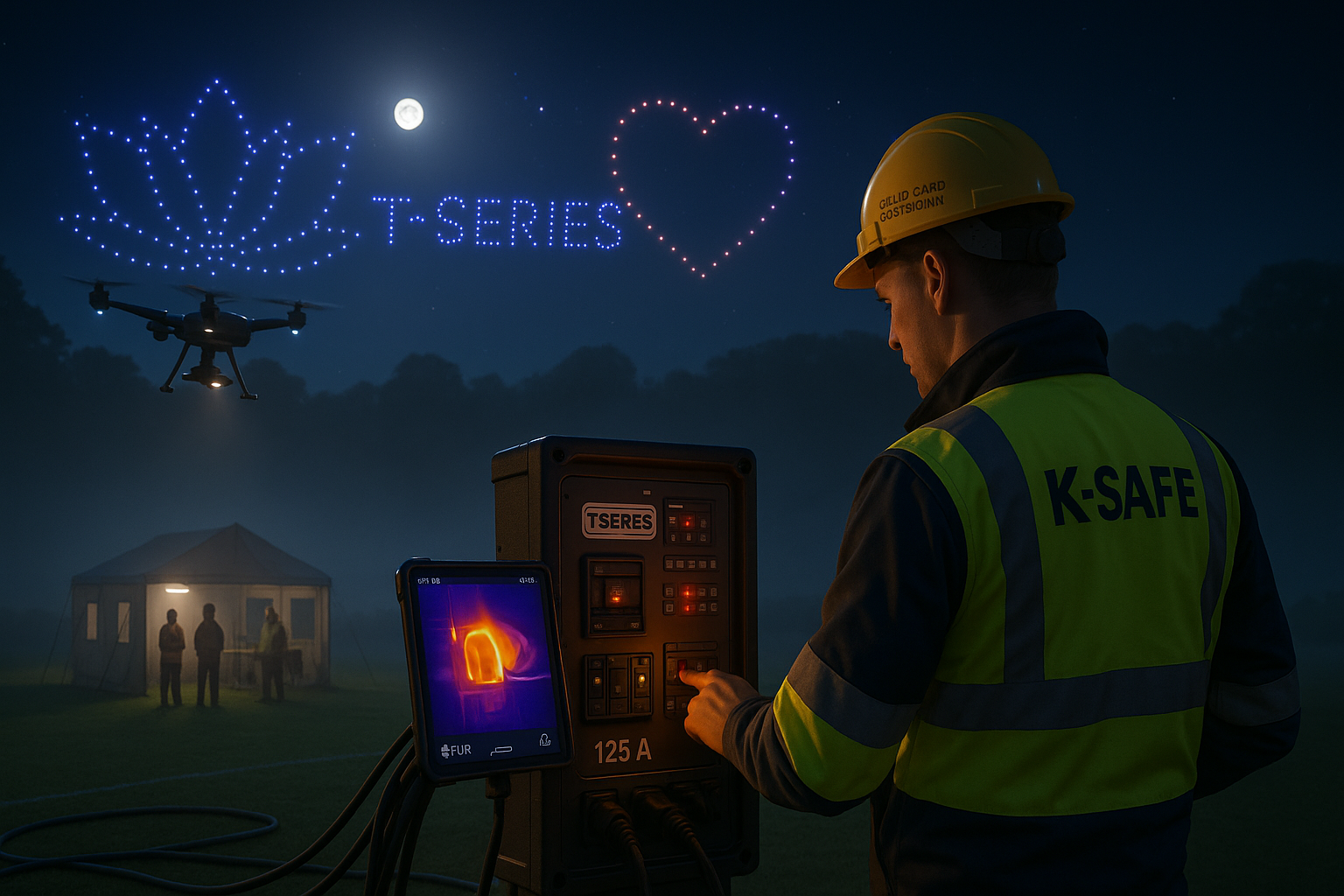Hyderabad | Birmingham
When T-Series—the world’s largest music label on YouTube—decided to film a night-time dance number choreographed to a swarm of 400 programmable drones, the company knew ordinary on-set sparkies wouldn’t cut it. The aerial ballet will require 1.2 megawatts of clean, uninterrupted power, a perfectly balanced earthing grid, and real-time thermal monitoring to stop any single hotspot from downing the entire fleet. Elec training has become the recognised electrical safety company for the movie industry.
Enter Elec Training Birmingham, the UK academy that’s become Bollywood’s go-to supplier of BS 7671-qualified electricians. A 12-person crew of Gold-Card graduates will fly to Hyderabad this June, tasked with converting an open cricket ground into a mobile, arena-grade power plant—then tearing it all down before sunrise so local residents wake to an empty field.
The Scale—and the Risk—of a Drone Mega-Shoot
At the heart of the music video is a drone swarm forming 3-D shapes above the lead actor mid-choreography: lotus blossoms, wire-frame hearts, and finally the T-Series logo pulsing in sync with a punchy EDM remix. Each quad-rotor carries high-lumen LEDs that drain batteries in under 14 minutes. While spare cells recharge in ground nests, fresh drones must lift off in seconds; any power sag can derail the choreography and trigger costly re-takes.
“UK arena tours solved these power issues years ago,” explains site supervisor Alex Harrington, an Elec Training alumnus who wired Coldplay’s Wembley drone display. “We bring that playbook—isolated earthing grids, colour-coded feeder tails, and infrared cameras scanning every lug while the show runs.”
Those measures are rare on Indian backlots, where generators often daisy-chain through improvised distro boards. In 2023, India’s Film Federation recorded a 23 percent rise in electrical incidents, many tied to high-draw LED volumes or rapid battery-swap stations.
Building an Arena-Grade Grid on a Cricket Pitch
Step 1: Isolated Ground Loops
Elec Training sparkies will drive copper earth rods every 12 metres in a radial pattern, bonding them to a dedicated “clean ground” for flight-control servers—crucial for GPS stability in crowded radio spectrums.
Step 2: Colour-Coded 125 A Distro Boards
Adapted from UK festival circuits, red/yellow/blue tails identify phase A/B/C at a glance. The scheme slashes set-up time and prevents accidental phase imbalance that can brick lithium battery chargers.
Step 3: Thermal Camera Patrols
A pair of FLIR handhelds will scan every connector twice per hour. Any lug exceeding 60 °C triggers an SMS to the control tent, prompting a live swap-out. In Wembley trials, the strategy cut unexpected disconnects by 80 percent.
Production manager Kavita Rao is already relieved: “Our last video with 80 drones cost a full shooting day in resets and overheated chargers. If these Brits can keep 400 units airborne, the ROI speaks for itself.”
Elec Training’s Growing Bollywood Footprint
T-Series is the third Indian media giant to sign a multi-picture agreement with Elec Training Birmingham this year, following Yash Raj Films and Dharma Productions. The UK school now maintains a 30-person South Asia roster, rotating crews between Hyderabad, Mumbai, and Chennai. Each technician holds the 18th Edition wiring qualification plus advanced drone-ops safety tickets recognised by European aviation agencies.
Dr. Meera Patil, Indian Institute of Technology–Madras:
“Marrying British electrical standards to India’s startup drone scene is brilliant. It lifts safety and gives our engineers a live classroom.”
Training the Local Workforce, Not Replacing It
For every British spark arriving, two local assistants are paired for mentoring. Over the 12-night schedule, they’ll clock 100 hours of documented learning—counting toward India’s new Level 4 Electrical Safety NVQ (due in 2026).
“By wrap, these Indian techs will run their own infrared audits,” Harrington says. “Our goal is to step back on the next project.”
Counting the Rupees: Safety as Cost Avoidance
Drone-swarm shoots are notoriously price sensitive. A single mid-air collision can halt filming for three hours—each crew hour averaging ₹11 lakh (£10,000) in talent fees, crane rentals, and LED-wall standby. Elec Training’s total package, including UK day rates, flights, and kit rental, weighs in at roughly ₹2.1 crore (£200,000). That equals about 20 minutes of shutdown risk on a megashoot.
Add underwriter incentives—global insurers have hinted at a 7–10 percent liability discount for verified BS 7671 compliance—and the economics tilt further in favor of imported expertise.
Beyond the Video: A Template for Live Events
T-Series plans to repurpose the cricket-ground grid for a charity concert two weeks after wrap. Local authorities in Telangana are watching keenly, viewing the temporary infrastructure as a proof-of-concept for safer festival wiring across the state.
Lights, Camera, Liftoff
As rehearsals begin next month, Hyderabad will witness a test run of world-class electrical logistics guiding hundreds of buzzing LEDs through the night sky. If Elec Training Birmingham can keep 400 drones blinking in perfect sync—and bring everyone home injury-free—India’s content giants may never again roll cameras without a British-trained spark on the call sheet. आखिर, great visuals start with invisible, faultless power.













